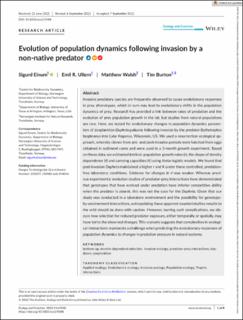| dc.description.abstract | Invasive predatory species are frequently observed to cause evolutionary responses in prey phenotypes, which in turn may lead to evolutionary shifts in the population dynamics of prey. Research has provided a link between rates of predation and the evolution of prey population growth in the lab, but studies from natural populations are rare. Here, we tested for evolutionary changes in population dynamics parameters of zooplankton Daphnia pulicaria following invasion by the predator Bythotrephes longimanus into Lake Kegonsa, Wisconsin, US. We used a resurrection ecological approach, whereby clones from pre- and post-invasive periods were hatched from eggs obtained in sediment cores and were used in a 3-month growth experiment. Based on these data, we estimated intrinsic population growth rates (r), the shape of density dependence (θ) and carrying capacities (K) using theta-logistic models. We found that post-invasion Daphnia maintained a higher r and K under these controlled, predation-free laboratory conditions. Evidence for changes in θ was weaker. Whereas previous experimental evolution studies of predator–prey interactions have demonstrated that genotypes that have evolved under predation have inferior competitive ability when the predator is absent, this was not the case for the Daphnia. Given that our study was conducted in a laboratory environment and the possibility for genotype-by-environment interactions, extrapolating these apparent counterintuitive results to the wild should be done with caution. However, barring such complications, we discuss how selection for reduced predator exposure, either temporally or spatially, may have led to the observed changes. This scenario suggests that complexities in ecological interactions represents a challenge when predicting the evolutionary responses of population dynamics to changes in predation pressure in natural systems. | en_US |

